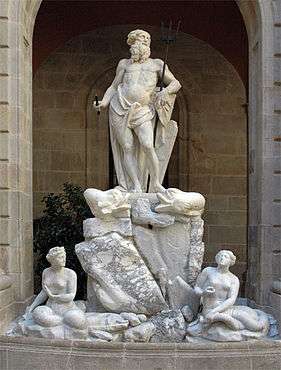Neptune (mythology)
Neptune (Latin: Neptūnus [nɛpˈtuːnʊs]) is the god of freshwater and the sea[1] in Roman religion. He is the counterpart of the Greek god Poseidon.[2] In the Greek-influenced tradition, Neptune is the brother of Jupiter and Pluto; the brothers preside over the realms of Heaven, the earthly world, and the Underworld.[3] Salacia is his wife.
| Neptune | |
|---|---|
God of the seas | |
 A velificans of Neptune in his seahorse-drawn triumphal chariot from the mid-3rd century AD - [loseer
[Sousse Archaeological Museum]]. | |
| Abode | Sea |
| Symbol | Horse, trident, dolphin |
| Festivals | Neptunalia; Lectisternium |
| Personal information | |
| Parents | Saturn, Ops |
| Siblings | Jupiter, Pluto, Juno, Ceres, Vesta |
| Consort | Salacia |
| Children | Triton, Proteus, Rhodes, Benthesikyme |
| Greek equivalent | Poseidon |
| Hinduism equivalent | Varuna |
| Religion in ancient Rome |
|---|
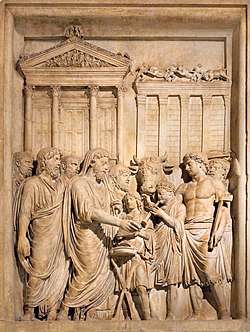 |
| Practices and beliefs |
| Priesthoods |
| Deities |
Deified emperors: |
| Related topics |
Depictions of Neptune in Roman mosaics, especially those of North Africa, are influenced by Hellenistic conventions.[4] Neptune was likely associated with fresh water springs before the sea.[5] Like Poseidon, Neptune was worshipped by the Romans also as a god of horses, under the name Neptunus Equester, a patron of horse-racing.[6]
Worship
_-_Foto_G._Dall'Orto.jpg)
The theology of Neptune may only be reconstructed to some degree, as since very early times he was identified with the Greek god Poseidon: his presence in the lectisternium of 399 BC is a testimony to the fact.[7] Such an identification may well be grounded in the strict relationship between the Latin and Greek theologies of the two deities.[8] It has been argued that Indo-European people, having no direct knowledge of the sea as they originated from inland areas, reused the theology of a deity originally either chthonic or wielding power over inland freshwaters as the god of the sea.[9] This feature has been preserved particularly well in the case of Neptune who was definitely a god of springs, lakes and rivers before becoming also a god of the sea, as is testified by the numerous findings of inscriptions mentioning him in the proximity of such locations. Servius the grammarian also explicitly states Neptune is in charge of all the rivers, springs and waters. He also is the lord of horses because he worked with Minerva to make the chariot.[10]
He may find a parallel in Irish god Nechtan, master of the well from which all the rivers of the world flow out and flow back to.
Poseidon on the other hand underwent the process of becoming the main god of the sea at a much earlier time, as is shown in the Iliad.[11]
In the earlier times it was the god Portunus or Fortunus who was thanked for naval victories, but Neptune supplanted him in this role by at least the first century BC when Sextus Pompeius called himself "son of Neptune."[12] For a time he was paired with Salacia, the goddess of the salt water.[13]
.jpg)
Neptune was also considered the legendary progenitor god of a Latin stock, the Faliscans, who called themselves Neptunia proles. In this respect he was the equivalent of Mars, Janus, Saturn and even Jupiter among Latin tribes. Salacia would represent the virile force of Neptune.[14]
Neptunalia
The Neptunalia was the festival of Neptune on July 23, at the height of summer. The date and the construction of tree-branch shelters[15] suggest a primitive role for Neptune as god of water sources in the summer's drought and heat.[16]
The most ancient Roman calendar set the feriae of Neptunus on July 23, two days after the Lucaria of July 19 and 21 and two days before the Furrinalia of July 25.
Georg Wissowa had already remarked that festivals falling in a range of three days are complementary. Dumézil elaborated that these festivals in some way were all related to the importance of water during the period of summer heat (canicula) and drought, when river and spring waters are at their lowest.
Founding his analysis on the works of Palladius and Columella Dumézil argues that while the Lucaria were devoted to the dressing of woods, clearing the undergrown bushes by cutting on the 19, then by uprooting and burning on the 21,[17] the Neptunalia were devoted to works of conservation and draining of superficial waters, thus corresponding to the Lucaria of 19, that required only work above the ground.
Then the Furrinalia of July 25, sacred to Furrina goddess of springs and wells, were devoted to those waters which had to be captured by drilling, i.e. required the work of man, thereby corresponding to the Lucaria of 21, which equally entailed human action upon the soil.
The Furrinalia are explained by Dumézil on the grounds of the hydraulic works prescribed by Palladius on this day, i.e. the drilling of wells to detect and capture underground water: the visible and the hidden waters are thus dealt with on separate, albeit next, occasions: the Neptunalia and Furrinalia. This complementarity between Neptunalia and Furrinalia corresponds to that between the first and second Lucaria, forming in fact two complementary couplets.
In recorded times the Neptunalia were spent in outings under branch huts (umbrae, casae frondeae), in a wood between the Tiber and the Via Salaria, drinking springwater and wine to escape the heat. It looks the Neptunalia were a time of general, free and unrestrained merrymaking, during which men and women mixed without the usual Roman traditional social constraints.[18] This character of the festival as well as the fact that Neptune was offered the sacrifice of a bull would point to an agricultural fertility context.[19]
Temples
In Rome Neptune had only one temple. It stood near the Circus Flaminius, the Roman racetrack, in the southern part of the Campus Martius. It already existed in 206 BC.[20] It appears on a coin struck by Gn. Domitius Ahenobarbus around 40 BC doubtless because of a restoration carried out by this personage. It contained a famous sculpture of a marine group by Scopas Minor.[21][22] The Basilica Neptuni, was built on the Campus Martius and dedicated by Agrippa in honour of the naval victory of Actium.[23] This building substituted the older temple, which in its turn substituted a more ancient altar.[24]

Sacrifices
Neptune is one of only four Roman gods to whom it was appropriate to sacrifice bulls, the other three being Apollo, Mars and Jupiter, although Vulcan was also allowed the offering of a red bull and a red bull calf.[25] The wrong offering would require a piaculum if due to inadvertency or necessity. The type of the offering implies a stricter connection between the deity and the worldly realm.[26]
Paredrae
Paredrae are entities who pair or accompany a god. They represent the fundamental aspects or the powers of the god with whom they are associated. In Roman religion they are often female. In later times under Hellenising influence they came to be considered as separate deities and consorts of the god.[27] However this misconception might have been widespread in earlier folk belief.[28] In the view of Dumézil,[29] Neptune's two paredrae Salacia and Venilia represent the overpowering and the tranquil aspects of water, both natural and domesticated: Salacia would impersonate the gushing, overbearing waters and Venilia the still or quietly flowing waters.[30] Dumézil's interpretation has though been varied as he also stated that the jolt implied by Salacia's name, the attitude to be salax lustful, must underline a feature characteristic of the god.[31]
Salacia and Venilia have been discussed by scholars both ancient and modern. Varro connects the first to salum, sea, and the second to ventus, wind.[32] Festus writes of Salacia that she is the deity that generates the motion of the sea.[33] While Venilia would cause the waves to come to the shore Salacia would cause their retreating towards the high sea.[34] The issue has been discussed in many passages by Christian philosopher St. Augustine. He devotes one full chapter of his De Civitate Dei to mocking the inconsistencies inherent in the theological definition of the two entitites: since Salacia would denote the nether part of the sea, he wonders how could it be possible that she be also the retreating waves, as waves are a phenomenon of the surface of the sea.[34] Elsewhere he writes that Venilia would be the "hope that comes", one of the aspects or powers of the all encompassing Jupiter understood as anima mundi.[35]
Servius in his commentary to the Aeneid also writes about Salacia and Venilia in various passages, e.g. V 724: "(Venus) dicitur et Salacia, quae proprie meretricum dea appellata est a veteribus": "(Venus) is also called Salacia, who was particularly named goddess of prostitutes by the ancient". Elsewhere he writes that Salacia and Venilia are indeed the same entity.[36]
Among modern scholars Dumézil with his followers Bloch and Schilling centre their interpretation of Neptune on the more direct, concrete, limited value and functions of water. Accordingly, Salacia would represent the forceful and violent aspect of gushing and overflowing water, Venilia the tranquil, gentle aspect of still or slowly flowing water.
Preller, Fowler, Petersmann and Takács attribute to the theology of Neptune broader significance as a god of universal worldly fertility, particularly relevant to agriculture and human reproduction. Thence they interpret Salacia as personifying lust and Venilia as related to venia, the attitude of ingraciating, attraction, connected with love and desire for reproduction. Ludwig Preller remarked a significant aspect of Venilia mentioning that she was recorded in the indigitamenta also as a deity of longing, desire. He thinks this fact would allow to explain the theonym in the same way as that of Venus.[37] Other data seem to point in the same direction: Salacia would be the parallel of Thetis as the mother of Achilles, while Venilia would be the mother of Turnus and Iuturna, whom she mothered with Daunus king of the Rutulians. According to another source Venilia would be the partner of Janus, with whom she mothered the nymph Canens loved by Picus.[38] These mythical data underline the reproductive function envisaged in the figures of Neptune's paredrae, particularly that of Venilia in childbirth and motherhood. A legendary king Venulus was remembered at Tibur and Lavinium.[39]
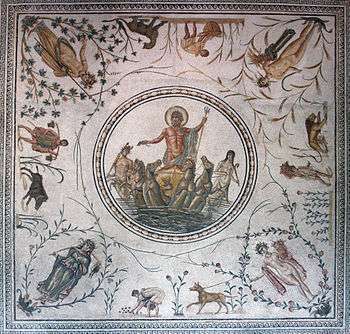

Neptunus equestris
Poseidon was connected to the horse since the earliest times, well before any connection of him with the sea was attested, and may even have originally been conceived under equine form. Such a feature is a reflection of his own chronic, violent, brutal nature as earth-quaker, as well as of the link of the horse with springs, i.e. underground water, and the psychopompous character inherent in this animal.[40]
There is no such direct connection in Rome. Neptune does not show any direct equine character or linkage.
Relation to Consus
On the other hand, Roman god Consus was associated with horses: his underground altar was located in the valley of the Circus Maximus at the foot of the Palatine, the place of horse races. On the day of his summer festival (August 21), the Consualia aestiva, it was customary to bring horses and mules in procession crowned with flowers and then hold equine races in the Circus.[41] According to tradition this occasion was chosen to enact the abduction of the Sabine (and Latin) women. The episode might bear a reflection of the traditional sexual licence of such occasions.[42] On that day the flamen Quirinalis and the vestal virgins sacrificed on the underground altar of Consus. The fact the two festivals of Consus were followed after an equal interval of four days by the two festivals of Ops (Opeconsivia on August 25 and Opalia on December 19) testifies to the strict relationship between the two deities as both pertaining to agricultural plenty, or in Dumezilian terminology to the third function. In Dumézil's view this fact shows the radically different symbolic value of the horse in the theology of Poseidon and of Consus. Tertullian (De Spectaculis V 7) states that according to Roman tradition Consus was the god who had advised Romulus on the abduction of the Sabines.[43]
Perhaps under the influence of Poseidon Ίππιος Consus, whose festival entailed horse races, was reinterpreted as Neptunus equestris and for his underground altar also identified with Poseidon Ένοσίχθων. Moreover, the etymology of Poseidon, understood as from Posis lord, husband and De grain or Earth, may have contributed to the identification of Consus with Neptune.[44] The archaic and arcane character of his cult, which required the unearthing of the altar, are signs of the great antiquity of this deity and of his chthonic character. On the basis of Augustine (De Civitate Dei IV 8 about the role of Tutilina in assuring the safety of stored grain), Dumézil interprets its name as derived from verb condere to hide, store, as a verbal noun in -u parallel to Sancus and Janus, meaning god of stored grains.[45] A direct identification of Consus with Poseidon in spite of all the data pointing to it is the fact that Poseidon is nowhere worshipped on underground shrines or altars.[46]
Martianus Capella places Neptune and Consus together in region X of Heaven: it might be that he followed an already old interpretatio graeca of Consus or he might be reflecting an Etruscan idea of a chthonic Neptune which is apparent in the recommendation of the De Haruspicum Responso[47] stating the need of expiations to Neptune for the prodigy of the cracking sounds heard underground in the ager latiniensis. Etruscans were particularly fond of horse races.[48]
Neptune in Etruria
Nethuns is the Etruscan name of the god. In the past it has been believed that the Roman theonym derived from Etruscan but more recently this view has been rejected.[49]Bonfante, Giuliano; Bonfante, Larissa (2002). The Etruscan Language: an Introduction. Manchester: University of Manchester Press. ISBN 0-7190-5540-7. p. 202.</ref> [50]
Nethuns was certainly an important god for the Etruscans. His name is to be found on two cases of the Piacenza Liver, namely case 7 on the outer rim and case 28 on the gall-bladder, (plus once in case 22 along with Tinia). This last location tallies with Pliny the Elder's testimony that the gall-bladder is sacred to Neptune.[51] Theonym Nethuns recurs eight times on columns VIII, IX and XI of the Liber Linteus (flere, flerchva Nethunsl), requiring offerings of wine.[52]
On a mirror from Tuscania (E. S. 1. 76) Nethuns is represented while talking to Uśil (the Sun) and Thesan (the goddess of Dawn). Nethuns is on the left hand side, sitting, holding a double ended trident in his right hand and with his left arm raised in the attitude of giving instructions, Uśil is standing at the centre of the picture, holding in his right hand Aplu's bow, and Thesan is on the right, with her right hand on Uśil's shoulder: both gods look intent in listening Nethuns's words. The identification of Uśil with Aplu (and his association with Nethuns) is further underlined by the anguiped demon holding two dolphins of the exergue below. The scene highlights the identities and association of Nethuns and Aplu (here identified as Uśil) as main deities of the worldly realm and the life cycle. Thesan and Uśil-Aplu, who has been identified with Śuri (Soranus Pater, the underwold Sun god) make clear the transient character of worldly life.[53] The association of Nethuns and Uśil-Aplu is consistent with one version of the theory of the Etruscan Penates (see section below).
In Martianus Capella's depiction of Heaven Neptune is located in region X along with the Lar Omnium Cunctalis (of everybody), Neverita and Consus. The presence of the Lar Omnium Cunctalis might be connected with the theology of Neptune as a god of fertility, human included, while Neverita is a theonym derived from an archaic form of Nereus and Nereid, before the fall of the digamma.[54] For the relationship of Neptune with Consus see the above paragraph. Martianus's placing of Neptune is fraught with questions: according to the order of the main three gods he should be located in region II, (Jupiter is indeed in region I and Pluto in region III). However, in region II are to be found two deities related to Neptune, namely Fons and Lymphae. Stephen Weinstock supposes that while Jupiter is present in each of the first three regions, in each one under different aspects related to the character of the region itself, Neptune should have been originally located in the second, as is testified by the presence of Fons and Lymphae, and Pluto in the third. The reason of the displacement of Neptune to region X remains unclear, but might point to a second appearance of the triads in the third quarter, which is paralleled by the location of Neth in case 7 of the Liver.[55] It is however consistent with the collocation in the third quadrant of the deities directly related to the human world.[56]
Bloch remarks the possible chthonic character and stricter link of Nethuns with Poseidon to which would hint a series of circumstances, particularly the fact that he was among the four gods (Jupiter, Saturn, Neptune and Tellus in order) the haruspices indicated as needing placation for the prodigy related in Cicero's De haruspicum responso 20, i.e. a cracking sound perceived as coming from the underground in the ager latiniensis.
Neptune and the Etruscan Penates
Among ancient sources Arnobius provides important information about the theology of Neptune: he writes that according to Nigidius Figulus Neptune was considered one of the Etruscan Penates, together with Apollo, the two deities being credited with bestowing Ilium with its immortal walls. In another place of his work, book VI, Nigidius wrote that, according to the Etrusca Disciplina, his were one among the four genera, types of Penates: of Iupiter, of Neptune, of the underworld and of mortal men. According to another tradition related by a Caesius,[57] also based on the same source, the Etruscan Penates would be Fortuna, Ceres, Genius Iovialis and Pales, this last one being the male Etruscan god (ministrum Iovis et vilicum, domestic and peasant of Jupiter).[58]
Etymology
The etymology of Latin Neptunus is unclear and disputed.[59] The ancient grammarian Varro derived the name from nuptus i.e. "covering" (opertio), with a more or less explicit allusion to the nuptiae, "marriage of Heaven and Earth".[60]
Among modern scholars Paul Kretschmer proposed a derivation from Indo-European *neptu- "moist substance".[61] Similarly Raymond Bloch supposed it might be an adjectival form in -no from *nuptu-, meaning "he who is moist".[62]
Georges Dumézil objected that words deriving root *nep- are not attested in Indo-European languages other than Vedic and Avestan. He proposed an etymology that brings together Neptunus with the Indian and Iranean theonyms Apam Napat and Apam Napá as well as with the Old Irish theonym Nechtan, all meaning "descendant of the waters". By using the comparative approach the Indo-Iranian, Avestan and Irish figures would show common features with the Roman historicised legends about Neptune. Dumézil thence proposed to derive the nouns from an Indo-European root népōts-, "descendant, sister's son".[63][64] His former student, the Estonian Indo-Europeanist Jaan Puhvel supposes that the name ultimately might have meant "child (neve, nephew) of the water", as part of an Indo-European "Fire in the Water"-myth.[65]
A different etymology grounded in the legendary history of Latium and Etruria was proposed by the 19th-century scholars Ludwig Preller, Karl Otfried Müller and Wilhelm Deeke: the name of the Etruscan deity Nethuns or Nethunus (NÈDVNVZ) would be an adjectival form of the toponym Nepe(t) or Nepete (presently Nepi), town of the ager Faliscus near Falerii. The district was traditionally connected to the cult of the god. Messapus and Halesus, the eponymous hero of Falerii, were believed to be his own sons. Messapus led the Falisci and others to war in the Aeneid.[66] Nepi and Falerii have been famed since antiquity for the excellent quality of the water of their springs, scattered in meadows. Nepet, however, might be considered a hydronymic toponym of pre-Indo-European origin, from an appellative meaning "damp wide valley, plain", cognate with pre-Greek νάπη, "wooded vale, chasm".[67]
Fertility deity and divine ancestor
More recently, in his lectures delivered on various occasions in the 1990s, German scholar Hubert Petersmann proposed an etymology from the Indo-European rootstem *nebh- related to clouds and fogs, plus suffix -tu denoting an abstract verbal noun, and adjectival suffix -no which refers to the domain of activity of a person or his prerogatives. The Indo-European root *nebh-, having the original meaning of "damp, wet", has given Sanskrit nābhah, Hittite nepis, Latin nubs, nebula, German Nebel, Slavic nebo etc. The concept would be close to that expressed in the name of Greek god Όυράνος (Uranus), derived from the root *h2wórso-, "to water, irrigate" and *h2worsó-, "the irrigator".[68][69] This etymology would be more in accord with Varro's.
Petersmann proposes a rather different interpretation of the theology of Neptune.[70] Developing his understanding of the theonym as rooted in IE *nebh, he argues that the god would be an ancient deity of the cloudy and rainy sky in company with and in opposition to Zeus/Jupiter, god of the clear bright sky. Similar to Caelus, he would be the father of all living beings on Earth through the fertilising power of rainwater. This hieros gamos of Neptune and Earth would be reflected in literature, e.g. in Vergil Aen. V 14 pater Neptunus. The virile potency of Neptune would be represented by Salacia (derived from salax, salio in its original sense of salacious, lustful, desiring sexual intercourse, covering). Salacia would then represent the god's desire for intercourse with Earth, his virile generating potency manifesting itself in rainfall. While Salacia would denote the overcast sky, the other character of the god would be reflected by his other paredra Venilia, representing the clear sky dotted with clouds of good weather. The theonym Venilia would be rooted in a not attested adjective *venilis, from IE root *ven(h) meaning to love, desire, realised in Sanskrit vánati, vanóti, he loves, Old Island. vinr friend, German Wonne, Latin Venus, venia. Reminiscences of this double aspect of Neptune would be found in Catullus 31. 3: "uterque Neptunus".[71]
In Petersmann's conjecture, besides Zeus/Jupiter, (rooted in IE *dei(h) to shine, who originally represented the bright daylight of fine weather sky), the ancient Indo-Europeans venerated a god of heavenly damp or wet as the generator of life. This fact would be testified by Hittite theonyms nepišaš (D)IŠKURaš or nepišaš (D)Tarhunnaš "the lord of sky wet", that was revered as the sovereign of Earth and men.[72] Even though over time this function was transferred to Zeus/Jupiter who became also the sovereign of weather, reminiscences of the old function survived in literature: e.g. in Vergil Aen. V 13-14 reading: "Heu, quianam tanti cinxerunt aethera nimbi?/ quidve, pater Neptune, paras?": "What, why have so many clouds enringed the sky? What are you preparing, father Neptune?".[73] The indispensability of water for its fertilizing quality and its strict connexion to reproduction is universal knowledge.[74] Takács too points to the implicit sexual and fertility significance of both Salacia and Venilia on the grounds of the context of the cults of Neptune, of Varro's interpretation of Salacia as eager for sexual intercourse and of the connexion of Venilia with a nymph or Venus.
Müller and Deeke had already interpreted the theology of Neptune as that of a divine ancestor of a Latin stock, namely the Faliscans, as the father of their founder heroes Messapus and Halesus. Sharing this same approach Fowler considered Salacia the personification of the virile potency that generated a Latin people, parallel with Mars, Saturn, Janus and even Jupiter among other Latins.[75]
Depiction in art
Neptune is depicted in the 7th and final movement of Gustav Holst's orchestral suite 'The Planets', subtitled 'The Mystic' as Holst described the god.
The French Department of Subaquatic Archaeological Research divers (headed by Michel L'Hour) discovered a lifesize marble statue of Neptune, in the Rhône River at Arles; it is dated to the early fourth century.[76] The statue is one of a hundred artifacts that the team excavated between September and October 2007.[76][77]
Etruscan representations of the god are rare but significative. The oldest is perhaps the carved carnelian scarab from Vulci of the 4th century BC: Nethuns kicks a rock and creates a spring. (Paris: Bibliothèque Nationale, Cabinet des Medailles).
Another Etruscan gem (from the collection of Luynes, inscribed Nethunus) depicts the god making a horse spring out of the earth with a blow of his trident.[78]
A bronze mirror of the late 4th century in the Vatican Museums (Museo Gregoriano Etrusco: C.S.E. Vaticano 1.5a) depicts the god with Amymone, daughter of Danaus, whom he prevents being assaulted by a satyr and to whom he will teach the art of creating springs.
A bronze mirror from Tuscania dated to 350 BC also in the Vatican Museums (Museo Gregoriano Etrusco E. S. 1. 76). Nethuns is talking to Usil and Thesan. In the lower exergue is an anguiped demon who holds a dolphin in each hand (identification with Aplu-Apollo is clear also because Uśil holds a bow). Nethuns holds a double-ended trident, suggesting he might be one of the gods who can wield lightningbolts.[79]
Gallery
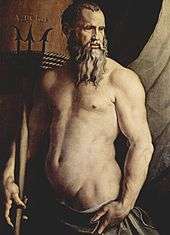 Agnolo Bronzino, Portrait of Andrea Doria as Neptune (1540–1550)
Agnolo Bronzino, Portrait of Andrea Doria as Neptune (1540–1550)
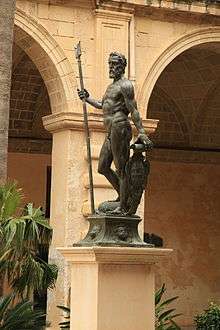
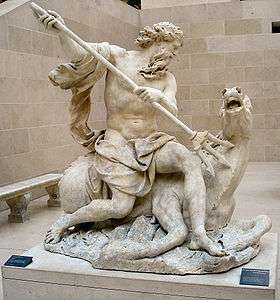
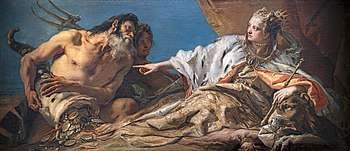 Giovan Battista Tiepolo, Neptune Offering Gifts to Venice (1748–1750)
Giovan Battista Tiepolo, Neptune Offering Gifts to Venice (1748–1750) Juan Pascual de Mena, Fuente de Neptuno, Madrid (1780–1784)
Juan Pascual de Mena, Fuente de Neptuno, Madrid (1780–1784)
 Neptune, tobacco product art (1860–1870)
Neptune, tobacco product art (1860–1870)
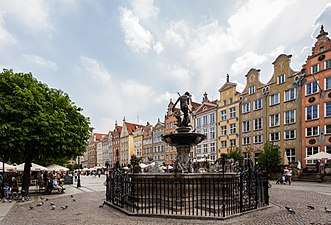
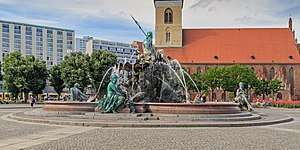 The Neptunbrunnen in Berlin
The Neptunbrunnen in Berlin
Bibliography
- Raymond Bloch 1981. "Quelques remarques sur Poseidon, Neptunus et Nethuns" in Comptes-rendus des séances de l' Académie des Inscriptions et Belles-Letres 2 pp. 341–352.
- Nancy Thomson De Grummond 2006. Etruscan Mythology, Sacred History and Legend: An Introduction, University of Pennsylvania Museum of Archaeology, ISBN 1-931707-86-3.
- Georges Dumézil 1977. La religione romana arcaica. Con un 'appendice sulla religione degli Etruschi Edizione e traduzione a cura di Furio Jesi: Milano Rizzoli (Italian translation conducted on an expanded version of the 2nd edition of La religion romaine archaïque Paris Payot 1974).
- William Warde Fowler 1912. The Religious experience of the Roman People London.
- Sarolta A. Takacs 2008. Vestal Virgins, Sibyls and Matronae: Women in Roman Religion, University of Texas Press.
- Georg Wissowa 1912. Religion und Kultus der Rőmer Munich.
References
- J. Toutain, Les cultes païens de l'Empire romain, vol. I (1905:378) securely identified Italic Neptune as a saltwater sources as well as the sea.
- Larousse Desk Reference Encyclopedia, The Book People, Haydock, 1995, p. 215.
- About the relationship of the lord of our earthly world with water(s) Bloch, p. 342-346, gives the following explanations: 1. Poseidon is originally conceived as a chthonic god, lord and husband of the Earth (for the etymolog gearoid γαιήοχος, he who possesses the Earth, εννοσίδας he who makes the Earth quake) with an equine form. He mates with Demeter under this form in the Arcadian myth from Thelpusa, they beget the racing horse Areion and the unnamed daughter of those mysteries (story in Pausanias VIII 25, 3). 2. Poseidon hippios (horse) is the god of Earth and as springs come from beneath the earth, this is also a metaphora (or better a figure) of the origin of life on Earth; the horse is universally considered as having a psychopompous character and Poseidon is known as tamer of horses (damaios) and father of Pegasus who with its hoof can open up a spring. 3. Poseidon is the god worshipped in the main temple of the Isle of Atlantis in the myth narrated by Plato in the dialogues Timaeus and Critias; there was also a hippodrome nearby. 4. The island was swallowed up by an earthquake caused by Poseidon himself. This factor would connect the power over earth and that over waters. The Greek had a memory of the explosion of the Island of Santorini and of the seaquake it provoked as well as other consequences affecting climate.
- Alain Cadotte, "Neptune Africain", Phoenix 56.3/4 (Autumn/Winter 2002:330-347) detected syncretic traces of a Libyan/Punic agrarian god of fresh water sources, with the epithet Frugifer, "fruit-bearer"; Cadotte enumerated (p.332) some north African Roman mosaics of the fully characteristic Triumph of Neptune, whether riding in his chariot or mounted directly on albino dolphins.
- Dumézil, La religion romaine archaïque, 381, Paris, 1966.
- Compare Epona.
- Livy v. 13.6; Dionysius of Halicarnassus 12.9; Showerman, Grant. The Great Mother of the Gods. Madison, WI: University of Wisconsin, 1901:223
- Raymond Bloch 1981 p.341-344.
- G. Wissowa Religion un Kultus der Römer Munich, 1912; A. von Domaszewski Abhandlungen zur römische Religion Leipzig und Berlin, 1909; R. Bloch 1981.
- Bloch 1981 p.346; Servius Ad Georgicas IV 24
- R. Bloch 1981
- Fox, Robin Lane. The Classical World. Basic Books, 2006. p. 412 ISBN 0-465-02496-3
- van Aken, Dr. A.R.A., ed. Elseviers Mythologische Encyclopedie (Elsevier, Amsterdam: 1961)
- W. W. Fowler 1912, p. 186 n. 3; citing Servius Ad Aen. V 724; later Doctor Fowler disowned this interpretation of Salacia.
- CIL, vol. 1,pt 2:323; Varro, De lingua Latina vi.19.
- "C'est-à-dire au plus fort de l'été, au moment de la grande sécheresse, et qu'on y construisaient des huttes de feuillage en guise d'abris contre le soleil" (Cadotte 2002:342, noting Sextus Pompeius Festus, De verborum significatu [ed. Lindsay 1913] 519.1)
- G. Dumézil Fêtes romaines d' été et d' automne. Suivi de Dix questions romaines Paris 1975 1. "Les eaux et les bois" p. 25-31.
- Sarolta A. Takacs Vestal virgins, sibyls and matronae: women in Roman religion 2008, University of Texas Press, p. 53 f., citing Horace Carmina III 28.
- Sarolta A. Takacs 2008; citing Macrobius Saturnalia III 10, 4.
- Cassius Dio 17 fragment 57. 60 as cited by L. Richardson jr. A New Topographical Dictionary of Ancient Rome 1992 p. 267.
- On the issue of this group by Scopas cf. F. Coarelli "L'ora di Domizio Enobarbo e la cultura artistica in Roma nel II sec. a. C." in Dialoghi di Arrcheologia II 3 1968 p. 302-368.
- Wukitsch, Thomas K., Neptunalia Festival
- Ball Platner, Samuel; Ashby, Thomas (1929), A Topographical Dictionary of Ancient Rome, "Basilica Neptuni", London: Oxford University Press
- Dumézil 1977 p. 340, who cites Livy Ab Urbe Condita Libri XXVIII 11, 4. Bloch 1981 p. 347 n. 19.
- Macrobius Saturnalia III 10,4
- G. Dumezil "Quaestiunculae indo-italicae: 11. Iovi tauro verre ariete immolari non licet" Revue d' Etudes Latins 39 1961 p. 241-250.
- William Warde Fowler The Religious experience of the Roman People London, 1912, p. 346f.
- Aulus Gellius Noctes Atticae XIII 24, 1-18.
- Dumézil here accepts and reproposes the interpretations of Wissowa and von Domaszewski.
- Dumezil above p.31
- G. Dumézil La religione romana arcaica, p. 340, Milano 1977.
- Varro Lingua Latina V 72.
- Festus p. L s.v.
- Varro apud Augustine De Civitate Dei VII 22.
- Augustine above II 11.
- William Warde Fowler The Religious Experience of the Roman People London, 1912, Appendix II.
- Ludwig Preller Römische Mythologie Berlin, 1858 part II, p.121-2; Servius Ad Aeneidem VIII 9.
- Ovid Metamorphoses XIV 334.
- Ludwig Preller above citing Servius; C. J. Mackie "Turnus and his ancestors" in The Classical Quarterly (New Series) 1991, 41, pp. 261-265.
- Bloch 1981 p. 343
- William Warde Fowler The Roman Festivals of the Period of the Republic London, 1899, p.
- W. W. Fowler, citing James G. Frazer.
- S. Dušanić, Ž. Petković "The Flamen Quirinalis at the Consualia and the Horseman of the Lacus Curtius" in Aevum 2002 1. p. 63.
- Sarolta A. Takacs Vestal Virgins, Sybils and Matrons University of Texas Press 2008 p. 55-56, also citing Scullard on the influence of horse races in the identification. Bloch 1981 citing Chantraine DELG s.v. Poseidon.
- Cf. the related deities of the Circus Semonia, Seia, Segetia, Tutilina: Tertullian De Spectaculis VIII 3.
- G. Capdeville "Jeux athletiques et rituels de fondation" Revue de l' histoire des religions.
- Cicero De Haruspicum Responso 20. Neptunus is mentioned third after Jupiter and Saturn and before Tellus.
- R. Bloch 1981; G. Capdeville "Les dieux de Martianus Capella" in Revue de l'Histoire des Religions 213-3, 1996, p. 282 n. 112
- Bloch 1981 p. 348.
- De Grummond, Nancy Thomson (2006). Etruscan Mythology, Sacred History and Legend: An Introduction. University of Pennsylvania Museum of Archaeology. ISBN 1-931707-86-3. p. 59.
- R. Bloch 1981; Pliny Nat. Hist. XI 195
- N. Thomas De Grummond Etruscam Myth, Sacred History and Legend Univ. of Pennsylvania Press 2006 p. 145.
- Erika Simon "Gods in Harmony: The Etruscan Pantheon" in N. Thomas De Grummond (editor) Etruscan Religion 2006 p. 48; G. Colonna "Altari e sacelli: l'area sud di Pyrgi dop otto anni di ricerche" Rendiconti della Pontificia Accademia di Archeologia 64 p. 63-115; "Sacred Architecture and the Religion of the Etruscans" in N.T. DeGrummond 2006 p.139
- Ludwig Preller Römische Mythologie Berlin, 1858, II p. 1
- G. Dumezil La religion romaine archaique Paris, 1974 2nd, Appendix; It. tr. p. 584; citing Stephen Weinstock "Martianus Capella and the Cosmic System of the Etruscans" in Journal of Roman Studies 36, 1946, p. 104 ff.; G. Capdeville "Les dieux de Martianus Capella" in Revue de l'Histoire des Religions 213-3, 1996, p. 280-281
- Cf. M. Pallottino "Deorum sedes" in Saggi di antichitá. II. Documenti per la storia della civiltá etrusca Roma 1979 p. 779-790. For a summary exposition of the content of this work the reader is referred to article Juno, section Etrurian Uni note n. 201.
- It is difficult to ascertain his identity.
- Arnobius Adversus Nationes III 40, 1-2.
- Michiel de Vaan, Etymological Dictionary of Latin and the other Italic Languages, Leiden/Boston 2004, p. 406.
- Varro Lingua Latina V 72: Neptunus, quod mare terras obnubuit ut nubes caelum, ab nuptu, id est opertione, ut antiqui, a quo nuptiae, nuptus dictus.: "N., because the sea covered the lands as the clouds the sky, from nuptus i.e. "covering", as the ancients (used to say), whence nuptiae marriage, was named nuptus".
- P. Kretschmer Einleitung in der Geschichte der Griechischen Sprache Göttingen, 1896, p. 33.
- R. Bloch "Quelques remarques sur Poseidon, Neptunus et Nethuns" in Revue de l' Histoire des Religions (1981), p. 347.
- Y. Bonnefoy, W. Doniger Roman and Indoeuropean Mythologies Chicago, 1992, p. 138-139, s.v. Neptune, citing G. Dumezil Myth et Epopée vol. III, p. 41 and Alfred Ernout- Atoine Meillet Dictionnaire étymologique de la langue latine Paris, 1985 4th, s.v. Neptunus.
- G. Dumézil Fêtes romaines d' étè et d' automne, suivi par dix questions romaines, p. 25, Paris 1975.
- Jaan Puhvel, Comparative Mythology, Baltimore 1987, p. 277-283.
- Vergil Aeneis, VII, p. 691: L. Preller Römische Mythologie, vol. 2, Berlin, 1858; Müller-Deeke Etrusker II 54 n. 1 b; Deeke Falisker p. 103, as quoted by William Warde Fowler The Roman Festivals of the Period of the Republic London, 1899, p. 185 and n. 3.
- Robert S.P. Beekes, Etymological Dictionary of Greek, Leiden/Boston 2010, p. 996.
- H. Petersmann below, Göttingen 2002.
- M. Peters "Untersuchungen zur Vertratung der indogermanischen Laryngeale in Griechisch" in Österreicher Akademie der Wissenschaften, philosophische historische Klasse, vol. 372, Vienna 1980, p. 180.
- Hubert Petersmann Lingua et Religio: ausgewählte kleine Schriften zur antiken Religionsgeschichte auf sprachwissenschaftlicher Grundlage herausgegeben von Bernd Heßen. Hypomnemata: Supplement-Reihe 1. Göttingen: Vandenhoeck und Ruprecht, 2002. Pp. 304. ISBN 3-525-25231-5.
- Catullus 31. 3: "Paene insularum, Sirmio, insularumque/ ocelle, quascumque in liquentibus stagnis/ marique vasto fert uterque Neptunus/...": the quoted words belong to a passage in which the poet seems to be hinting to the double nature of Neptune as god both of the freshwaters and of the sea.
- Eric Neun Die Anitta-Text Wiesbaden, 1974, p. 118.
- H. Petersmann "Neptuns ürsprugliche Rolle im römischen Pantheon. Ein etymologisch-religiongeschichtlicher Erklärungsversuch" in Lingua et religio. Augewählte kleine Beiträge zur antike religiogeschichtlicher und sprachwissenschaftlicher Grundlage Göttingen, 2002, pp. 226-235.
- cf. Festus s. v. aqua: "a qua iuvamur", whence we get life, p 2 L.; s. v. aqua et igni : "...quam accipiuntur nuptae, videlicet quia hae duae res...vitam continent", p.2-3 L; s.v. facem: "facem in nuptiis in honore Cereris praeferebant, aqua aspergebatur nova nupta...ut ignem et aquam cum viro communicaret", p.87 L.
- William Warde Fowler The Roman Festivals of the Period of the Republic London, 1899, p. 126
- Divers find Caesar bust that may date to 46 B.C., Associated Press, 2008-05-14
- Henry Samuel, "Julius Caesar bust found in Rhone River", The Telegraph
- Jacques Heurgon, in Bloch 1981 p. 352.
- N.T. De Grummond 2006 p. 145.
External links
| Wikimedia Commons has media related to Neptunus (deus). |
- Warburg Institute Iconographic Database (ca 600 images of Neptune)
- Chisholm, Hugh, ed. (1911). . Encyclopædia Britannica (11th ed.). Cambridge University Press.
